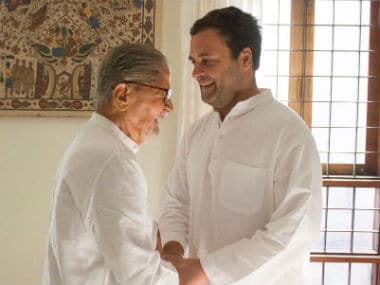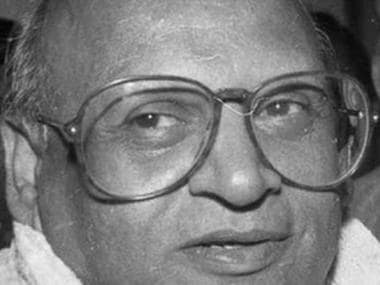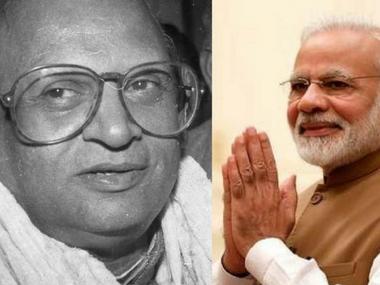Narendra Modi is mostly a sui generis politician. In simple language, one of a kind, in a class by himself. But there are two former chief ministers of Gujarat whose tricks and tactics must have gone into the making of Modi. Consider it this way: When a younger Modi, as BJP state unit organisational secretary, was trying to make space for the party, he had to contend with these two gentlemen more than the rest.
These “purvasuris” (predecessors) of Modi are Madhavsinh Solanki (Congress) and Chimanbhai Patel (mostly Congress). Adjectives such as maverick and shrewd come to the tip of the tongue at any mention of them. One started as a journalist in Ahmedabad, the other as an economics lecturer in the same city. They had so much success that it eventually led to the downfall of the Congress and remains the root cause of the urban, ‘upper-caste’ middle-class Gujarati’s as-yet unending alienation from the grand old party.
Madhavsinh Solanki
The so-called upper castes, even with limited numbers, dominated the political scene in Gujarat right from the beginning, and thus the first few chief ministers were Brahmin or Patel: Jivaraj Mehta, Balwantrai Mehta, Hitendra Desai, Ghanshyam Oza, Chimanbhai Patel, Babubhai Jashbhai Patel. Madhavsinh Solanki was the first chief minister from a caste that later came to be counted among the OBC.
His first term was of barely hundred days, during the Emergency. But in the 1980 Assembly election, he led the Congress to victory on 141 out of 182 seats. (The BJP’s best tally so far is 127.) He was the first chief minister—and the only one before Modi—to complete a full term and led the party in the next round of elections in 1985.
In these five years, he rejigged the caste equations drastically. He was supremely successful: In 1985, the Congress won 149 seats. This overwhelming success was thanks to a formula devised by him and veteran Congressman Jhinabhai Darji, called ‘KHAM’: Wooing Kshatriya, Harijan, Adivasi and Muslims voters instead of Patels, Baniyas and Brahmins. His 1980 Cabinet did not have a single Patel. The new strategy also entailed enlarging quota benefits, which in 1982 and 1985 backfired with caste agitations that turned into communal riots. That finally gave an opportunity to the BJP, and ever since the ‘upper castes’ have seen that party as their saviour.
Ahmedabad and other cities suffered frequent bouts of riots, but the one in 1985 is worth special mention. Clashes started in February-March and ended only in July, when the Congress ‘high command’ finally replaced Solanki with his home minister, Amarsinh Chaudhary, the first tribal chief minister, who brought in super-cop Julio Ribeiro. Some parts of old Ahmedabad suffered from, anecdotally speaking, the longest-lasting curfew in independent India.
Solanki had a fourth term, for 85 days in 1989-90, before he moved to Delhi. In the PV Narasimha Rao government, he served as the external affairs minister but he had to resign, infamously, for ferrying a letter in connection with the Bofors case.
Then something most curious for an Indian politician happened. Solanki happily went into retirement in March 1992, though he was in his mid-60s. (He is 90 today, same age as LK Advani.) He has, going by reports, not intervened in state politics all these years, though his son, Bharatsinh Solanki, is a Congress leader in the state. Those who know him speak of his courtesy, grace, elegance, and a highly cultivated taste in literature. He’s also an avid bird-watcher.
Chimanbhai Patel
Chimanbhai is one of those curious characters but for whom Indian politics would have been dull and dry. (By the way, ‘bhai’ and ‘ben’ in Gujarati names are not to be taken literally. Here, ‘bhai’ is a mild honorific, dropping which—as a national daily’s Ahmedabad edition once did on front page back then—can sound insulting. Replacing it with ’lal’, as Modi’s mention of “Mohanlal”, can be mildly insulting or harmless jest.)
His first term, in 1973-74, should have been uneventful, but for a students’ agitation. They were protesting the hostel mess charge hike, but it soon became a popular, statewide agitation against everything people were unhappy with, from price rise to corruption scandals. The Navnirman agitation was a precursor to Jayaprakash Narayan’s call for Total Revolution and a precursor to the Emergency. The chief minister faced slogans of ‘Chiman Chor’ for alleged corruption and his rule ended ignominiously.
He was in wilderness for a long time, as Solanki took the Congress on a different trajectory. Gujaratis had mostly forgotten him, when he sprung up from nowhere: As the Gujarat leader of the ragtag army VP Singh was putting together against the Congress in the name of Janata Dal. The anti-corruption plank made VP the prime minister, and in one of those paradoxical turns of history, it also made Chimanbhai the chief minister of Gujarat, with the BJP’s support.
There were still more twists and turns. After the chariot-borne Advani’s arrest in Bihar in 1990, the BJP withdrew support to the VP government: And that meant withdrawal of support to the Chimanbhai government too. Chimanbhai coolly changed the name of the party to Janata Dal (Gujarat), and found support from the Congress, in alignment with the Congress’s support to Chandra Shekhar in Delhi. JD-G was to eventually merge into the Congress, but not before adding a knot to the messy conundrum Solanki had left for the party.
The Congress, after Solanki, lost the support of Patels, Baniyas and Brahmins, who were now with the BJP. The Ram Janmabhoomi campaign had sealed that deal, and the BJP had even co-opted the ‘lower castes’ into the project. Against this backdrop, the Congress could have at least consolidated what Solanki brought home. Instead, it was vainly chasing the Patels again.
Chimanbhai was aware of this anomaly. He prefigures Modi in several ways: He sought to overcome caste complexities by foregrounding economy and development. For example, he organised a month-long grand mela in Ahmedabad, a precursor of sorts to the Vibrant Gujarat jamboree, showcasing Gujarat’s industries and development. Unlike his predecessors, he knew what a hot-button issue the Sardar Sarovar could be. He repeatedly spoke of the Narmada being the “lifeline of Gujarat”, and galvanised public opinion for the project with ample help from some hugely respected Gandhian NGOs. He left little option for the Opposition but to join his cause.
His industry-friendly, development-oriented outlook was, of course, a façade for a new caste politics: His policies arguably promoted the interests of the urban, upper-caste middle class, while giving new dreams for the rest to dream.
That was the stage set for the BJP. But for his untimely death in February 1994 at the age of 64, he might have tried a few more somersaults but he might not have lasted long in the face of the rising Hindutva. His widow, the late Urmilaben, who was a Rajya Sabha member, and son Siddharth Patel, who is a senior Congress leader, failed to carry on his legacy.
Follow Narendra Modi in Gujarat on our liveblog here
Read complete coverage of Gujarat Elections 2017 here


)



